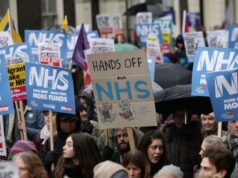Issue: 25
May 2015
This occasional newsletter is researched, written and edited by a group of concerned residents in Ealing, West London who want to preserve our NHS. We view the wholesale engagement of private, for-profit healthcare service suppliers as unnecessary, profligate and dangerous. Process improvement is what is needed in our NHS – not revolution.
Ealing Save Our NHS (ESON)
For over three years this campaigning group has fought to save Ealing’s hospitals and our NHS from cuts, closures and privatisations. On 30 April 2015 ESON together with Hammersmith’s Save Our Hospitals campaigning group presented a 15,000 signature petition to Health Minister Jeremy Hunt at the Department of Health in Westminster. The signatories want the new Government to suspend plans to close Ealing Hospital Maternity unit, cut 600 beds from Ealing and Charing Cross Hospitals and take away their A&E units.
See https://www.facebook.com/ealingsaveournhs
Will NHS Still Be Centre Stage After the General Election?
Somehow I doubt it – whatever the result.
However, locally politically sensitive healthcare documents and decisions – no doubt many of them already written and made – may well enter the public domain after the election. They include:
+ The new ‘Shaping a Healthier Future’ Business Case
+ The date of the closure of Ealing Hospital’s Maternity Unit
+ The demolition and new build plans for the Ealing Hospital site
+ Sir Bruce Keogh’s new definition of a ‘Modern A&E Unit’ which no doubt will be the blue print of the yet to-be-built new not-really-an-A&E-unit –as-we-know-it on the Ealing Hospital site
+ The McKinsey report on the reasons for the A&E Type-1 chaos in NHS North West London post the September 2014 A&E closures
+ The final report of the North West London Commission on Health
+ The fate of Solace, the Bowman’s Close, West Ealing walk-in mental health centre.
Pressure on A&E Has Not Increased and Is Not Increasing
Colin Standfield of Save Our Hospitals continues quoting NHS statistics which refute the Coalition Government’s lie that there is increasing pressure on NHS hospital A&E units.
From November 2010 to March 2015 Type-1 A&E (the most seriously ill) attendances have remained steady – averaging at 273,388 per week. In fact recently they have dropped below this figure.
So the recent A&E chaos is not to do with what patients are doing to A&E, it is a result of hospital closures (5 in London alone, 2 of those here in NW London), bed cuts and savage culling of social care, meaning that people cannot be discharged from hospital.
North West London Commission on Health: Initial Report
This excellent report, published on 26 March 2015, contains the initial findings of the independent commission chaired by Michael Mansfield QC. The report was written by independent consultants Sean Boyle and Roger Steer. For those of you who may not have the time to read the 119 page report, I have tried below to summarise and highlight the findings which constitute a review of ‘Shaping a Healthier Future’ (SaHF).
- SaHF HISTORY
A McKinsey and Company report to Government in 2009 put forward the view that the NHS spends too much money on acute care and that £billions could be saved by shifting care from acute hospital settings. NHS boss Nicholson demanded £20 billion savings on NHS costs across England during the period 2009 to 2015.
Out of this came the approach in NHS North West London to save one £billion by 2015 by downgrading four of the nine major hospitals, moving expensive acute hospital care into cheaper Out of Hospital (OOH) services and primary care, and centralising services at five major hospitals.
The decision to downgrade four major hospitals – and close four hospital A&E units – was taken before any public consultation was undertaken. The report is critical of the consultation as it simplistically asked residents which hospital they wanted downgraded.
- ACCESS TO CARE
SaHF offers poor access to care especially for those living in deprived areas. A formal needs assessment for the 1.9 million population is missing from SaHF. What is evident is that SaHF supplied a set of assumptions about what reductions in demand were needed for all SaHF’s pre-determined capacity reductions to work.
A&E Capacity and Performance
SaHF claimed that North West London is overprovided with A&E units. The commission could find no data to back up this claim. Authoritative data from multiple sources shows that reducing A&Es from nine to five would create loadings on each of the surviving A&Es which would be 50% more than the national average.
In North West London over the last four years A&E attendance fell by 26.2 %. Urgent Care Centre usage seems to be the explanation here. A&E performance in North West London has deteriorated since the closure of the A&Es at Hammersmith and Central Middlesex hospitals in September 2014. Type-1 (the most ill patients) performance is the most concerning. For some weeks performance was the worst in England. SaHF is in denial about A&E closures being responsible for this disastrous performance. SaHF refused to release a report on the subject produced by McKinseys.
OOH Care
SaHF proposed to transform OOH care – spending up to £310 million over five years. All eight Clinical Commissioning Groups (CCGs) provided detailed plans on what they would achieve by March 2015. However there is very little to show what has been actually achieved by this date.
Beds
SaHF claims there is excess capacity, but it is unclear whether the growth in population has been sufficiently factored into calculations of the number of beds required.
- QUALITY OF CARE
SaHF is all for specialisation and centralisation of services. It favours big hospitals. However the commission could find no recent evidence which supports the case for centralisation of acute services.
Maternity
SaHF’s reason for reducing the number of maternity units is difficulty in recruiting and retaining consultants and midwives at each of the seven sites. SaHF also claims it’s uneconomic to retain Ealing Hospital’s maternity unit. However SaHF has not provided a detailed financial analysis to back up this claim is not available from SaHF.
Emergency Services
Lots of published papers quoted in the report refute SaHF’s claims for centralisation of services and closure of four A&Es. The commission’s findings are that a much stronger case should have been put forward to justify the closure of one A&E unit – never mind four!
OOH
The evidence on the impact of OOH services on the demand for acute services does not support the conclusion that five acute units will be able to support the needs of 1.9 million people.
- THE BUSINESS CASE
Financial considerations are the ultimate driver for SaHF. This section of the report examines the unproven results of OOH expansion, the affordability, risks, uncertainties and deliverability of the SaHF programme. It questions whether the SaHF costs are under control, whether double –counting is going on in SaHF, and whether too little is being spent on our healthcare anyway.
SaHF cost £62.9 million in 2013/14, yet NHS NW London enjoyed a cash surplus of £100.1 million. In 2014/15 figures are more difficult to source but an overall loss of £14.9 for NHS NWL is identified. (The overall cost of SaHF (2010/11 to 2017/18 ) is projected to be £235.5 million of which £35.43 million is for management consultancy.)
NHS NWL is apparently in overall balance so why were there two A&E closures in September 2014? This was at a time when it had not been proven that SaHF plans were affordable, deliverable or financed.
QIPP and SaHF Entanglement
Possible double counting of cost savings revolve around the NHS Quality, Innovation, Productivity and Prevention ( QIPP) programme and SaHF. QIPP may have already succeeded in making the savings needed without recourse to SaHF closures. The Commission thinks it unlikely that QIPP or SaHF programmes will meet the 44.5% savings required by 2020. SaHF’s refusal to release its latest business case makes it impossible to unravel SaHF (and QIPP) projections and savings.
Should More Be Spent on Healthcare?
Whether you choose money, nurses, doctors or beds as your yardstick the UK has lower numbers than Germany, France and the USA. But in 2009 McKinsey told the Government that the UK had high hospital costs and utilisation costs.
Financial Benefits of SaHF
In 2012 annual savings by implementing SaHF of £135 million were stated. However the commission has been told that the capital costs have been significantly underestimated, as has population growth. Annual savings might be significantly lower that £135 and might render SaHF plans unaffordable.
Investment in OOH
The creation of new and enhanced OOH services should precede any reconfiguration of acute services. There is no evidence of these new or enhanced services. There is no evidence that there are large reductions in acute capacity as a result of extensions to OOH services.
Affordability
As well as investing £250 million in OOH services, SaHF needs £750 invested in acute services. Can NHS NWL afford this? Only a review of the latest SaHF business case might provide clues to this.
Risks
The report questions whether the SaHF is deliverable. It questions who owns the project – the NHS Commissioning Board, local CCGs or key local providers? The fact that the programme director has changed several times is not a positive sign. The report highlights many risks – service planning, safety, quality, business interruption, estates and construction, delay and adverse publicity.
The report proposes that SaHF develop a more conservative ‘Do Minimum’ option which would be easier to finance and easier to manage.
- A FLAWED PROCESS
Framing the Problem
SaHF came into being during a period of great turbulence in the NHS nationally, regionally and locally. The North West London Strategic Health Authority and Primary Care Trusts were being abolished. CCGs were being created and many hospitals were wrestling with trying to attain Foundation Trust status. There was therefore no stable strategic platform to plan major changes in service delivery.
The report cites the failure of the ‘Better Services Better Value 2011’ project in South West London. With many similarities to SaHF the project was abandoned in the face of its unsustainability. The commissioners predict a similar fate for SaHF.
Diagnosing the Problem
SaHF is based on assertions. These assertions include that only five major hospitals are affordable in North West London and that the need to improve quality of primary care implies there should be a reduction in acute capacity. However the SaHF strategy should have been based on local needs’ assessments, a deep analysis of the nature of the problems and detailed research on costs in the current system.
SaHF Objectives
Not clearly stated or followed. Why choose A&E services for reconfiguration-based quality improvement? A&E represents a small percentage of healthcare spending. Quality improvements could be made which would not involve a major reconfiguration and a capital spend of £1 billion.
The Options Appraisal Process
The commissioners believe too few options were considered by SaHF. Critically a ‘Do Minimum’ option was not considered. This breaks Treasury guidelines and its absence could lead to SaHF failing to gain Treasury approval.
Public Consultation
The public in 2012 were not presented with an approved business case. (In fact an approved business case still does not exist). Current plans are much more expensive and the benefits much less that those initially proposed to the public in 2012.
Local Authorities Ignored
Local authorities have been starved of information and involvement. It’s clear that they have developed doubts as to whether SaHF can deliver what it has promised.
RECOMMENDATIONS
The commissioners want the whole SaHF programme to be halted and independent reviews to take place on the September 2014 A&E closures and the planned A&E closures at Charing Cross and Ealing Hospitals. They want the assertion that OOH services can effectively substitute for acute capacity and save money to be reviewed. When the new business case emerges if it is significantly different from the one presented to the public in 2012, then a new public consultation exercise must be mounted.
More on the Healthcare Commission
The fourth public hearing of evidence by the commission will take place at Brent Civic Centre on Saturday 9 May 2015 from 9:30am to 4:30pm. Representatives of SaHF have promised to attend and be interviewed at this event.
Health Commission witness statements, hearings, transcripts etc can be viewed at:
http://www.bpv.org.uk/the-independent-healthcare-commission/
How Seamless and Effective is integrated Healthcare and Social Care in England?
Not very might well be the answer.
In 2014/15 there was a 23% annual increase in ‘delayed transfer of care’ – 306,581 incidents in 2013/14 and 375,700 incidents in 2014/15. These transfers are from acute to non-acute (including community and mental health) care and occur when a hospital patient is ready to be transferred but can’t be for one reason or another and is still occupying a hospital bed. These figures suggest that patients’ length of stay in hospitals is rising – however the most recent data on this is not yet available.
For patients to be transferred back to their homes engagement with family and friend carers is necessary, as can be nursing and social care staff who can visit the patient at home. NHS district nurses often provide or manage the healthcare needs of those at home. However, during the period 2003 to 2013 there was a 47% reduction in qualified district nurses in England. In 2014 the Royal College of Nursing called for the number of district nurses in England to rise to 10,000 (what it was in 2009). In 2013 there were only 6,700 district nurses and more than a third of them were over 50 years old.
As for social care provision, this is a Local Authority service. According to the Association of Adult Social Services (ADASS) Government funding for adult social services has dropped by 12% since 2010, whilst demand had risen by 14%. Age UK reported in January 2015 that the number of people receiving meals on wheels had declined by 64% between 2010/11 and 2013/14. During the same period those receiving home help for washing and dressing fell by a third and the number of day care places dropped by two-thirds.
Only the vulnerable poor who are assessed as having ‘substantial’ or ‘critical’ needs get free social care from Local Authorities. The rest have to pay for social care. Most Local Authorities have sold off the care homes they once owned. In fact of the 430,000 elderly and disabled people who live in care homes only 10% live in those still owned by the NHS or a Local Authority.
It seems to me that many thousands of care co-ordinators are needed across England to knit together community healthcare and social care. Logic says that they should be employed by the state. However looking at job advertisements for care co-ordinators they have all been placed by private care companies. None of them seem to be NHS vacancies. If elderly people are blocking beds surely pro-active initiatives (research/co-ordination) by hospital co-ordinators with close family/friends, the Local Authority, Age UK, District Nurses and care homes might just unblock beds somewhat faster? Or maybe GP surgeries should employ care co-ordinators for their vulnerable, disabled and elderly patients. However Local Authorities, NHS hospitals and GP surgeries will all claim that they cannot afford to employ care co-ordinators.
Which brings us to the £5.3 billion Better Care Fund (BCF) which went ‘live’ on 1 April 2015. BCF’s original reason for existence was to transform local health and social care services by pooling resources. However it’s still mired in conflict. Local government wants the funds to be used to support adult care services. The NHS wants it to be spent on healthcare. National Government wants it spent on reducing hospital admissions and making £1 billion NHS savings by 31 March 2016.
For the first time in our history there are over 10 million over 65 year olds in the UK and of these 1.4 million are over 85. The ONS predicts that these figures will rise to 15 million and 4.2 million by 2035. Improving the quantity and quality of healthcare and social care and their integration for the elderly is going to be an even bigger challenge in the future than it is now.




